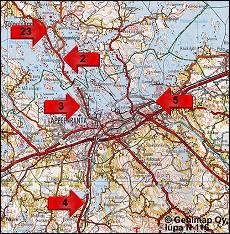
|
|
Site Map: Sites 2-5
|
Hill fort in Kuivaketvele, Taipalsaari
Set high up on steep rocks, the ancient castles were places of shelter and defence where people took refuge during the Iron Age when the enemy threatened. On the least steep side of the rock, there are one or more stone bulwarks which were probably once the foundations for wood fortifications. Building and maintaining the castles required extensive organisation and cooperation. Construction of the ancient castles was begun at the end of the Iron Age. About 100 of them are known in Finland. They were in use generally from 800 to 1300 A.D.
On the least steep, southeastern side of Taipalsaari's Kuivaketvele hill fort lie the remains of the stone foundation of an ancient wood fortification. Inside the bulwark is the top of a rock, almost a hectare in size. The exact age of the castle is not yet known. In addition to the Kuivaketvele hill fort, two other hill forts have been identified in Taipalsaari: the Kannus and the Turasalo hill forts. Viking-era burial grounds in Vammonniemi and Mammonniemi indicate that people lived in Taipalsaari during the Iron Age. At these burial grounds, ashes of the dead and burial offerings were hidden in hollows in the rock or in cairns.
The top of the hill fort offers a magnificent view of Lake Saimaa. Steps have been built into the steepest parts of the hill fort.
Driving directions: Take Taipalsaarentie road (no. 408) from the centre of Lappeenranta and drive towards Taipalsaari for about 6.5 km. Turn right onto Linnavuorentie road. Continue about 400 metres. The site is on the right side of the road. There is a parking area for cars and buses.
